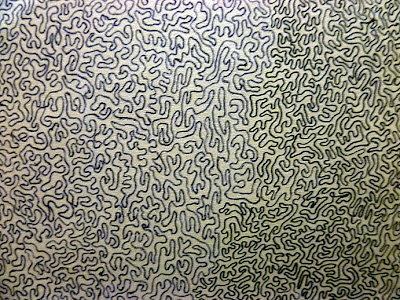The V&A is definitely my favourite museum, as it's full of design pieces of various sorts. I knew it would be an excellent place to go to look for 'pattern'. The current main exhibition there is 'Imperial Chinese Robes - from the Forbidden City'. Traditional Chinese textiles are always really interesting because there's so much to look at on the fabric, in comparison to say traditional British textiles, that are generally far more simple.
I had an hour to kill before I could go into the exhibition, so I looked around the Medieval and Renaissance galleries.
(Reliquary Casket, 1185-95)
I find most religious art, particularly from this period, very beautiful. The work that goes into the pieces is amazing. The section from the Reliquary Casket is from the back, yet it is as detailed and interesting as the front.
(Details from The Arnstein Bible, 1172, text illumination by the Monk Lunandus)
I realised that the same colours were used in most of the Medieval pieces. A lot of reds, golds and blues. Everything is very repetitive, and therefore very recognisable. The text illuminations were my favourite exhibit from the collection as there is more attention focused on the lines, rather than the representation of people. It is hard to follow a line in the image, as there are always others curling around and going off in different directions.
(The Clare Chasuble, 1272-94)
The exhibition was packed, but after shoving a few old ladies out of the way I managed to get a good look at the work on show. Please note that there was no shoving involved, I am far too respectful (and modest..). An old northern gent even wished me luck on my future career!
(Top & bottom: Emperor's dragon robe, 1736-95)
These details were from my favourite item within the collection. I was really struck by the simplicity colourwise. Most of the pieces, though amazing, were just so loud, cramming as many primary colours into the design as much as possible. There was something about the combination of only brown and gold that made this robe stand out more than the others.
I concentrated on the wave design at the bottom of the robe, as I liked the combination of lines. Waves symbolise the difference between the human world and the 'Three Isles of the Immortals'.
(Empress's winter court skirt, 1662-1722)
(Details from: Empress's informal robe, 1875-1908 and Man's informals sleeveless waistcoat, 1862-1908)
The circular character was repeated in various forms on most of the garments. It represents longevity. I just liked how recognisable it was. They're made up of such simple shapes, yet they're quite confusing.
The crane is also a symbol of longevity, and it is believed that they carry the spirits to the heavens. I wanted to concentrate on the detail of the crane - every feather is drawn, rather than a whole wing shape. The attention to detail fascinates me.
I'd like to experiment with embroidery on various materials. I really like the way everything in Chinese art is symbolic, but not in a pretentious symbolic way.
To relate it to The Petits Pois (fake band) I need to design some symbols. They'll probably need to relate to peas.. which could prove difficult. I would also quite like to not have to use green all the time. I think circular motifs could work well without being green.

















































